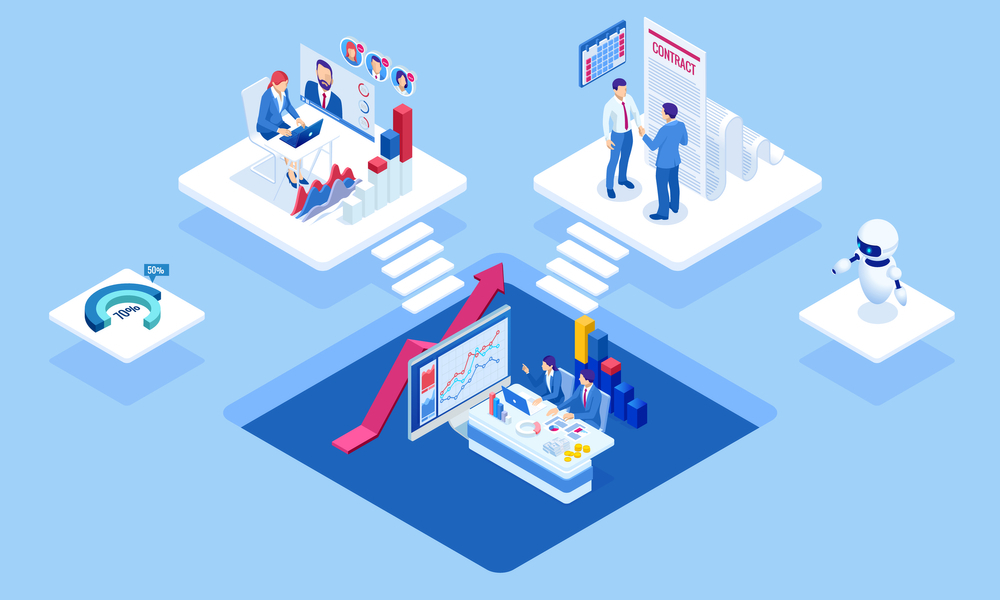Can We Scale A B2B Sales Model? It Is Possible Thanks To The End2End Models
Imagine being able to personalize each one of the commercial proposals to adapt them to the maximum to the possible clients. This is probably one of the biggest dreams of any business team.
Although it may seem like a utopia, it is possible thanks to many of the digital tools that exist today. The pandemic has forced the replacement of traditional sales processes and many professionals have tried to adapt to this forced digitization but in many cases they have not done it in the appropriate way since what they have ended up doing has been to copy traditional processes, believing that this is already the case. They were digital.
One way of visualizing this is the following: if we could place the B2B business processes of companies on a coordinate axis where X is automation and Y is business intelligence, we would discover that the vast majority of them would be located in a complicated area, with little automation and without much business intelligence.
How could I digitize my recruitment strategy?
According to eWorldTrade experts, the idea is to start building processes that really add value by taking advantage of technology to automate part of the initial funnel, but always with intelligence. In this way we will be making our operations much more effective.
Have you ever suffered on LinkedIn the typical chain of messages that do not contribute anything? Take it as an example of what not to do.
But before launching, remember that you must be clear about your recruitment strategy.
Now the big question: how can I do it? The answer is much simpler than it seems and to build a process that adds value to your potential clients you just have to be clear about the following indications:
- Define your recruitment strategy and what the objective you want to achieve is.
- Segment the accounts, looking for the niches in which you are strong.
- Identify the decision – makers of each of the accounts.
- Provide real value, think about your problems and try to solve them.
- Automate part of the process, but in an intelligent way.
Keep in mind that technology will help us with parts of the process in which we do not add value.
How can we propose a Digital Sales B2B strategy?
When we talk about implementing the Digital Sales B2B strategy, we mean using the End2End methodology in processes, taking advantage of the digital world and technology to obtain the necessary data to effectively personalize the entire process.
This model consists of analyzing each of the actions and then applying the improvements, based on the data, in the previous steps to continuously optimize the process. In this way we can see the viability of the proposed strategy, being able to decide in a very agile way whether to continue with it or not.
The procedure to implement this methodology goes through the fulfillment of the following operating process:-
1. Market segmentation: We will have to carry out a preliminary analysis, both internal and external. The objective is to obtain our value proposition and the sector in which we are strong (either because we are in a blue ocean or because our brand is well positioned). Once we have defined our value proposition and which sector it is in which we can add value, it is time to segment the accounts into three levels.
- Vital: These are the accounts that are a priority for our company so the efforts will be greater, as will the customization have applied.
- Sectorial: Those that are not essential but are within an important sector for the company. The effort will decrease and we will begin to automate parts of the process.
- General: Accounts that we do not want to spend too much time on either because they are not within our vertical or because we do not have a good positioning. In this case, we will apply little customization and a lot of automation. We do not want to dedicate almost company resources.
2. Communication strategy: We will define the decision makers of the selected accounts and we will build for them an empathy map in which we will see what their pain points are and how we can help them.
3. Design and operational phase: At this time we will see in which channels and how we can begin to generate interactions with each of the decision makers. It will also be time to decide which points require automation. But remember to be smart.
4. Recruitment campaigns: Launch of the first campaigns (they do not have to be campaigns with advertising investment). We will begin to measure the first KPIs, so this will be one of the critical points to decide if the previous points were carried out successfully or we have to rethink our strategy.
5. Opportunities categorization: The idea here is not to generate a lot of prospects, moreover, we must prioritize quality, and so the most important thing is to start generating interactions with them, offering valuable content to qualify leads. At this point, automation begins to lose importance since we want to give a more humane treatment (quantity vs quality).
6. Commercial operation: When we really know the lead’s problems, his concerns and he knows how we can help him, only then can we say that we have an opportunity to offer a demo to close a collaboration. The rest is fooling yourself.
7. Analysis and measurement: It really is a totally transversal process to the entire conversion funnel, but here we already have the complete picture so it is when we can apply all the knowledge acquired (successes and failures) to work on both sides of the operational flow.
8. Optimization: We know what has worked and what has not, so we will apply it at the beginning, making the following actions much more effective, reducing B2B sales times and obtaining higher returns.
In short, the guarantee of success lies in using all the information that the digital world gives us about our potential clients. We must take advantage of it to anticipate the problems they may have and provide a solution, automating only the phases in which a business developer does not add value.
The best of all? This process is totally transversal, regardless of what your sector is. The only thing that you will have to adapt will be the channels and tools that you will use.
nancy yates

